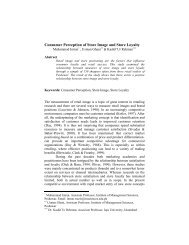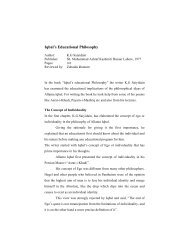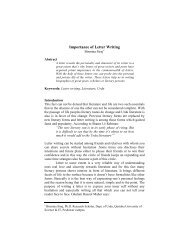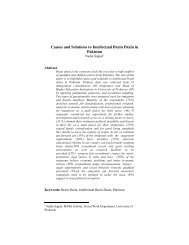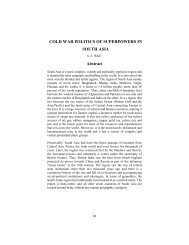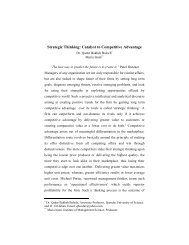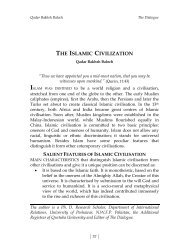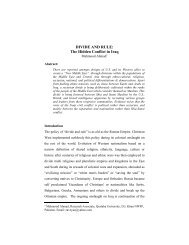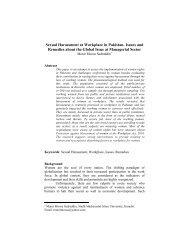Implementation Gaps between Theory and Practice
Implementation Gaps between Theory and Practice
Implementation Gaps between Theory and Practice
You also want an ePaper? Increase the reach of your titles
YUMPU automatically turns print PDFs into web optimized ePapers that Google loves.
Legal Protections Provided Under Pakistani Law against<br />
Anti-Women <strong>Practice</strong>s: <strong>Implementation</strong> <strong>Gaps</strong> <strong>between</strong> <strong>Theory</strong> <strong>and</strong> <strong>Practice</strong><br />
Zaheer & Shamreeza<br />
Note & References<br />
1 John L. Esposito, Women in Muslim Family Law (New York: Syracuse<br />
University Press, 1982), 13.<br />
2 ibid.<br />
3 Fatima Umar Naseeef, Women in Islam: A discourage in Rights <strong>and</strong><br />
Obligations, Trans. Saleeha Mahmood Abedin, (Cairo: International Committee<br />
for Women <strong>and</strong> Child, 1999), 47.<br />
4 Ibid., 48<br />
5 Al Quran, 17:70.<br />
6 John L. Esposito, Women in Muslim Family Law, op.cit., 13<br />
7 Sawara is a Pashto word denoting a child marriage custom in tribal areas of<br />
Pakistan <strong>and</strong> Afghanistan. This custom is tied to blood feuds among the<br />
different tribes <strong>and</strong> clans where the young girls are forcibly married to the<br />
members of different clans in order to resolve the feuds.<br />
8 Wanni is a child marriage custom in tribal areas of Pakistan.<br />
9 Badla-e-Sulh means giving a female in marriage contract or otherwise<br />
compelling her for marriage as a reconciliation of a family dispute.<br />
10 “Facets of Violence Against Women Gender Justice <strong>and</strong> Protection Project”,<br />
United Nations Development Program Pakistan, 2009.<br />
11 ibid.<br />
12 ibid.<br />
13 “Prevention of Anti-Women <strong>Practice</strong>s” (Criminal Law Amendment) Act,<br />
2011, http://www.na.gov.pk/uploads/documents/1321415693_161.pdf, (last<br />
accessed on 26 February, 2012).<br />
14 Rakhshinda Perveen, “Violence Against Women in Pakistan: A qualitative<br />
review of statistics for 2009”, Violence against Women Watch Group, (2009).<br />
15 ibid.<br />
16 ibid.<br />
17 It is a kind of council of elders from the community that works as local<br />
judiciary in rural areas of Pakistan. Its decisions are considered binding on local<br />
masses.<br />
18 Muhammad Tahir Mansoori, Family Law in Islam (Islamabad: Shariah<br />
Academy, International Islamic University, 2009), 5<br />
19 The phrase mithaqanghaliza implies that marriage is sacred <strong>and</strong> sanctified<br />
contract, which is higher in status than ordinary civil contracts.<br />
20 Mansoori, Family Law in Islam, op.cit., 5<br />
21 Muhammad Munir, “Marriage in Islam: A Civil Contract or a Sacrosanct?”,<br />
Hamdard-Islamicus, Vol. XXXI, No. 1, (2008)<br />
22 Muslim Jurists regard nikah or marriage to be both wordly affair (mu’amlh)<br />
<strong>and</strong> an act of worship (ibadah) at the same time.<br />
23 At that time girls were buried alive in the name of honor.<br />
24 It provides punishment for giving a female in marriage or otherwise in Badali-Sulh.<br />
It states that “whoever gives a female in marriage or otherwise in Badali-Sulh<br />
shall be punished with rigorous imprisonment which may extend to ten<br />
years but shall not be less than three years”.<br />
The Dialogue 183<br />
Volume VIII Number 2




